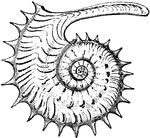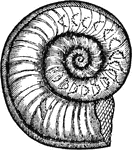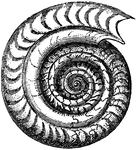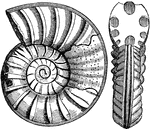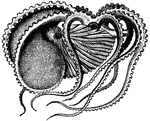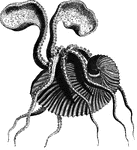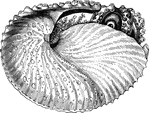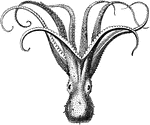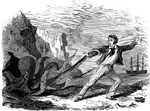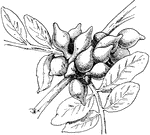The Squid, Octopus, and Nautilus ClipArt gallery includes 132 illustrations of squid, octopus, nautilus, and ammonites. These animals are members of the mollusk (or mollusc) class of cephpalopods, named cephalopoda.

Ammon's Horn (Shell)
An illustration of an Ammon's Horn shell, a fossil shell, curved like a ram's horn. A name previously…
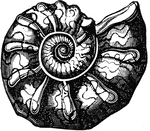
Ammonite
"They were of various forms, but they were of carnivorous habits, resembling the speias, and, like the…

Ammonite
"Ammonite is the name for a large genus of fossil chambered shells."—(Charles Leonard-Stuart,…

Ammonite
"Ammonite is the name for a large genus of fossil chambered shells."—(Charles Leonard-Stuart,…
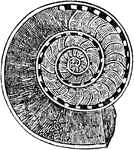
Ammonite
"Section of Ammonites obtusus, showing the interior chambers and siphuncle." — Chambers' Encyclopedia,…
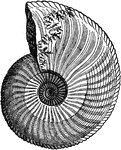
Ammonite
Ammonite, side view. Where the shell has been partly worn away near the aperture, the complex "suture…
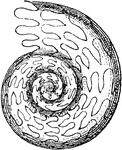
Ammonoid
"Goniatites henslowi. GONIOTITES. A genus of fossil ammonites, giving name to the family Goniatitidae,…

Argonaut
"A genus of cephalapodous mollusca, pretty generally known by the name of Paper Nautilus, and in consequence…
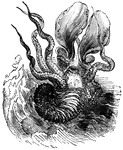
Greater Argonaut
The greater argonaut (Argonauta argo) is a cephalopod and a species of pelagic octopus also known as…
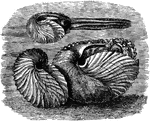
Argonaut, or Paper Nautlius
"The uppermost figure in the illustration shows the Argonaut in the act of swimming. The extremity of…
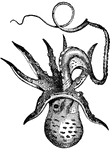
Argonauta argo
"Argonauta argo (male), with hectocotylized arm attatched. (several times smaller than the female, though…

Argonauta argo
"Argonauta argo (female), swimming in the direction of the large arrow- the smaller showing the current…
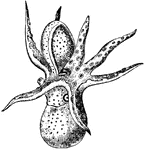
Argonauta Argo
"Male of Argonauta argo, with the hectocotylized arm still ontained in its enveloping cyst, four times…
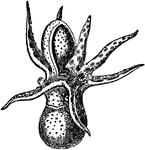
Argonauta Argo
Male of Argonauta argo, with the hectocotylized arm still contained in its enveloping cyst.
!["The Paper-nautilus, or Argonaut, [floats] gracefully on the surface of the sea, trimming its tiny sail to the breeze, just sufficient to ruffle the surface of the waves, it looks like an exquisite living shallop."](https://etc.usf.edu/clipart/51600/51666/51666_argonau_argo_mth.gif)
Argonauto Argo (Linnaeus)
"The Paper-nautilus, or Argonaut, [floats] gracefully on the surface of the sea, trimming its tiny sail…
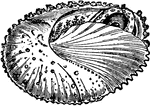
Argonauta Papyracea in its Shell
"The argonaut can blush, turn pale, and show through its transparent shell its body changing in sudden…
Argonauta Papyracea Swimming
"The principal apparatus of progression of the animal is the funnel with which it is furnished, in common…
Loligo brevipinna
"A small species, the body three to four inches long, beak prominent and horny; the long arms slender,…
!["The Pen-Fish or Common Calamary, <em>L. vulgaris</em>, is the best-known species of the genus; the body is somewhat pellucid, of a greenish hue, changeable to dirty brown; the eyes are large and lustrous, of an emerald green, phosphoric, and fiery in a high degree. It is common in the european seas, and was known to the ancient Greeks and Romans. [Shown with a quill pen]" — Goodrich, 1859](https://etc.usf.edu/clipart/14000/14004/cmncalamari_14004_mth.gif)
Common calamari
"The Pen-Fish or Common Calamary, L. vulgaris, is the best-known species of the genus; the…

Cephalopod
The cephalopods are the mollusk class Cephalopoda characterized by bilateral body symmetry, a prominent…
Cephalopod
A simple straight-shelled cephalopod. Where the shell has been removed, the straight sutures are shown.

Cephalopoda
"Cephalopoda is a class of mollusks, the highest in organization of the division of the animal kingdom.…
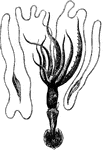
Bonelli's Cheiroteuthis
"Has the body eight inches long, and the longest tentacles nearly three feet." — Goodrich, 1859
!["In one genera [of the <em>Octopodidae</em> family] the arms are completely united in their whole extent by a thin membrane."](https://etc.usf.edu/clipart/51600/51665/51665_cirrh_muller_mth.gif)
Cirrhoteuthis Mulleri (Eschricht)
"In one genera [of the Octopodidae family] the arms are completely united in their whole extent…
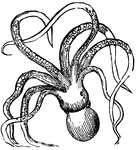
Cuttle-fish
A molluscous animal, having arms furnished with sucking-cups, by means of which it attaches itself tenaceously…
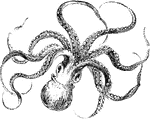
Cuttle-fish
Cuttlefish are animals of the order Sepiida, and are marine cephalopods, small relatives of squid and…

Cuttlebone
Cuttlefish "bone" or internal shell. The fine point at the base structure represents the guard of the…
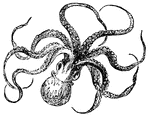
Cuttlefish
The body of the cuttlefish is soft and covered only with a leathery skin. Its eight arms are very long.

Cuttlefish
Cephalopods are the most highly organized Molluscs. The head is distinct, carrying two large globular…
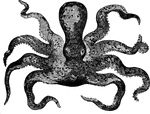
Cuttlefish
"The cuttlefishes have a strange method of walking, head-downward, on their outspread arms; they can…
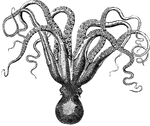
Cuttlefish
"It has no shell, and no skeleton, but has two conical pieces of horny substance imbedded in the back,…

Cuttlefish
"Twelve to eighteen inches long; the skin smooth, whitish, and spotted with brown and purple." —…

Cuttlefish
Cuttlefish are marine animals of the order Sepiida belonging to the Cephalopoda class. Despite their…
